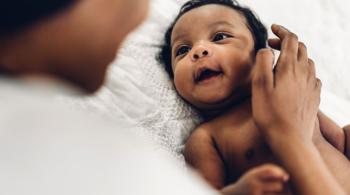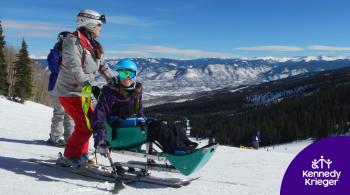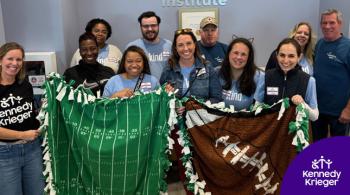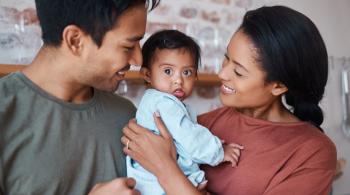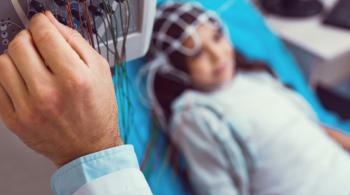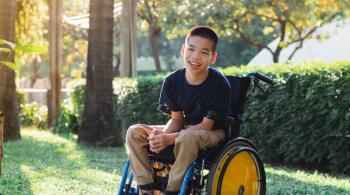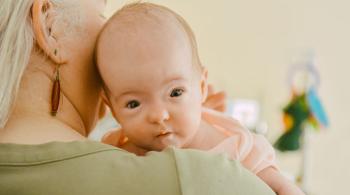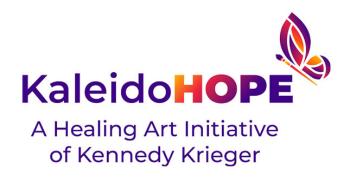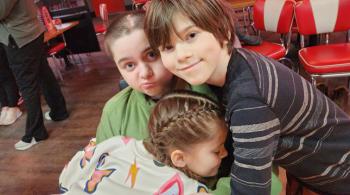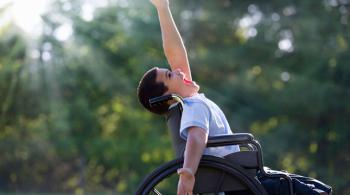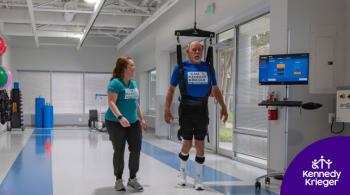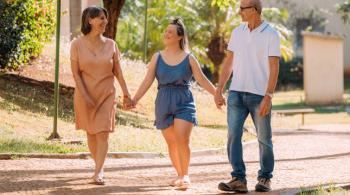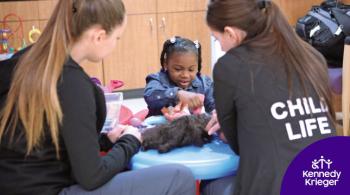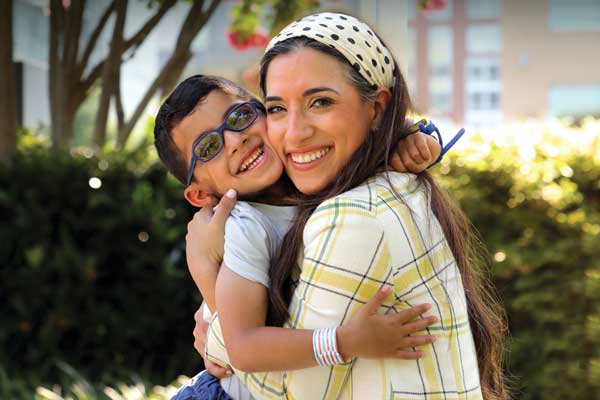
Daniel with his mom, Dr. Chani Simhi
By Laura Thornton
Dr. Joanna Burton will never forget that October day in 2018 when she received an urgent phone call from the mother of one of her patients.
Daniel, then 3, was no longer experiencing near-constant seizures, his mom, Dr. Chani Simhi, said.
He’d had an average of at least 40 seizures a day for the first three-plus years of his life—“those are the ones we could count,” Dr. Simhi says—but all of a sudden, the seizures subsided. Would it be possible for him to start intensive therapy at Kennedy Krieger Institute as soon as possible, while his seizures remained at bay?
Elated for Daniel and his family, Dr. Burton answered at once: “Of course!”
Daniel was born with a cervicomedullary arteriovenous fistula—a dense knot of blood vessels in his brain stem that can put pressure on the brain and lead to seizures and brain malformations, explains Dr. Burton, a developmental neurologist. He also has linear nevus sebaceous syndrome, a rare disorder that affects systems and organs throughout the body. The seizures delayed Daniel’s development, and for the first few years of his life, he was mostly nonverbal and had trouble moving the left side of his body. But once he was no longer seizing throughout the day, amazing things began to happen.
“This was an incredible window for him to finally access learning and his environment,” says developmental neuropsychologist Dr. Gwendolyn Gerner, who along with Dr. Burton co-directs the Institute’s Infant Neurodevelopment Center, where Daniel received evaluations, recommendations and follow-up care as a baby and toddler.
“He was finally able to pay attention to a task,” to be able to complete a full therapy session, and benefit from it, Dr. Burton explains. “We did not want to miss this opportunity.”
Dr. Burton made a quick call to Kristine Mauldin, the nurse case manager for the Institute’s Specialized Transition Program (STP), a neurorehabilitation day hospital. Within 10 days, Daniel was enrolled in the program. For six weeks, he had two hours of physical, occupational and speech therapies every weekday—just the right amount of therapy recommended for him at the time, Mauldin explains.
Giving Daniel the World—Through Words
Daniel still receives these therapies throughout the year, through Kennedy Krieger’s outpatient therapy programs and Community Rehabilitation Program (in which a therapist visits a patient in the patient’s home), as well as at school.
Speech-language pathologist Mary Boyle has worked with Daniel for more than three and a half years in outpatient appointments, both in person and via telehealth. When she first met Daniel, he only knew a few words. But within a year and a half, he was understanding English, Spanish and Hebrew, and starting to communicate in all three.
Boyle helped Daniel build up his vocabulary and learn how to put words together to make sentences, ask questions and talk about his feelings. They worked on storytelling and recounting stories, and on scripts—how to ask an adult for help, for example. “In three years, he’s gone from not talking, to telling simple sentences, to using three to five sentences sequenced together to tell stories and talk about himself,” Boyle says. “It’s remarkable.”
Daniel still has seizures, but usually only one or two a day, and they’re brief, explains Daniel’s neurologist, Dr. Eric Kossoff, who directs Johns Hopkins Medicine’s Child Neurology Residency Program. Now his body responds to epilepsy medication, which hadn’t been the case during the first few years of his life. Dr. Kossoff checks in with Daniel’s parents periodically to be sure Daniel’s medications are working well and to tweak the dosage, if needed.
Being able to use language to communicate also means Daniel has the ability to talk about the seizures, and can advocate for himself. That will make it easier for him to gain independence and agency in his medical care as he grows up.
“It will also help him not be scared of his seizures,” Boyle says. “They’re not something we don’t talk about. We must give him the language to talk openly about his seizures, and the feelings he has about them. We need to talk about how the seizures are a part of who he is, without any judgment, and that will allow him to feel that he is whole, just as he is.”

Coming Into His Own
Daniel has also worked closely with occupational therapist Sapna Bansil, both in person and via telehealth. When she first met Daniel, in early 2019, he had very limited speech. But at a recent therapy session, “He was telling me everything he ate that day, and about his friends at school,” she says. “His infectious personality is on full display. He’s energetic, talkative, sweet and friendly—it’s been really wonderful to see his personality emerge. He really has come into his own.”
In her earliest sessions with Daniel, Bansil worked on very basic motor skills with him, doing things like putting together a puzzle. More recently, they’ve been working on drawing shapes and cutting them out with scissors, as well as coloring and writing—skills he uses to succeed in school.
When Daniel was 4, Dr. Burton and Dr. Gerner jointly evaluated him, through the Institute’s Center for Development and Learning and Department of Neuropsychology respectively, to see what his needs would be in the classroom. “We found clear evidence that Daniel could learn in a highly structured environment,” Dr. Burton says. That evaluation helped Daniel’s parents find just the right school for their son, one that would provide him with exactly the right amount of support he needed to learn and grow. Since then, Daniel’s team at Kennedy Krieger has worked with the school to ensure his medical and learning needs are met each day. This fall, he starts second grade.
Great, Great Strides
Now 7, Daniel cracks jokes, loves playing with his sisters, and enjoys going to school, his mom says. “He’s super social, loves talking, loves basketball and playing with toy cars and balls, loves jumping on the trampoline and playing outside and riding his scooter, and is super, super loving.”
It takes so many people from such a wide range of fields to make him who he is. Lots of people have had such a great impact.” – Dr. Chani Simhi, Daniel’s mom
Daniel’s parents once wondered if their son would be able to communicate. “But he is talking, and he’s very expressive, and he’s making great, great strides,” says his mom, who is teaching him how to read in Hebrew. “I’m hopeful that when he’s 13, he’ll be able to have a bar mitzvah, because he can read Hebrew. We were so worried he might not be able to have opportunities like that.”
“I’m in incredible awe of Daniel and what he has accomplished over the years,” Dr. Gerner adds. “Every point along the path that I’ve seen him, he’s made astronomical gains.”
Daniel also receives care from ophthalmologist Dr. Michael Repka, vice chair for clinical practice at Johns Hopkins Medicine’s Wilmer Eye Institute. “We’re working to optimize his vision,” Dr. Repka explains. Daniel has had eye surgery to help his eyes coordinate with each other, and for a brief time, he wore a patch over his left eye, to strengthen the development of his right eye.
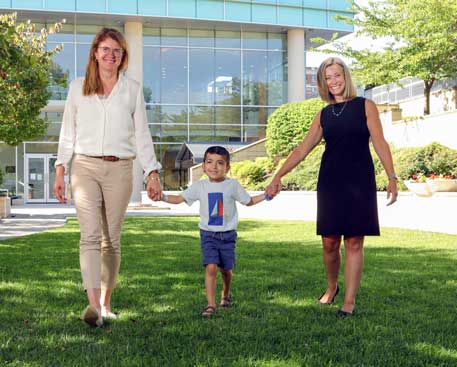
Daniel with Mary Boyle (left) and Dr. Gwendolyn Gerner
“So many different parts of the Kennedy Krieger-Johns Hopkins community were able to come together, at the right time, and help him get to where he is now,” Dr. Burton says. “At each stage of his development, we were able to give him just what he needed to make the next leap. No one department could have done that, nor could he have done that without the help of his parents and community.”
“It takes so many people from such a wide range of fields to make him who he is,” his mom says. “Lots of people have had such a great impact.”
“Having patients like Daniel is incredibly humbling,” Dr. Gerner adds, “because you realize it’s a combination of the whole team coming together, plus Daniel’s persistence and determination, that’s made all the difference.”

